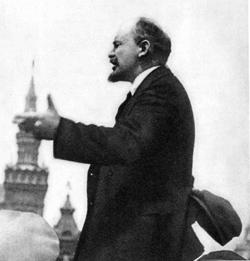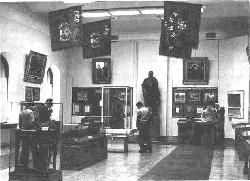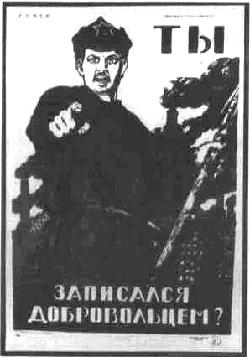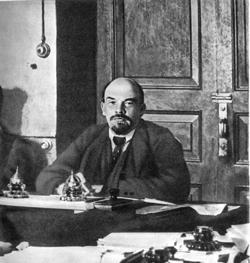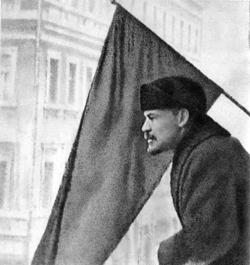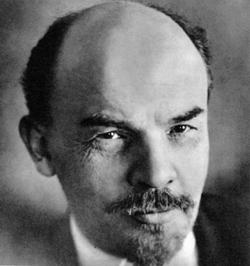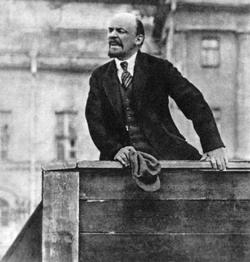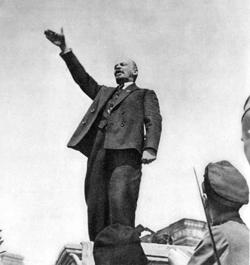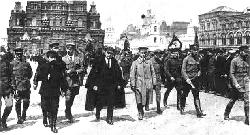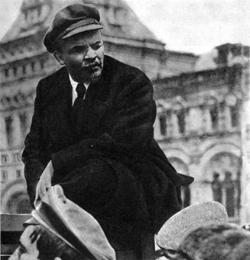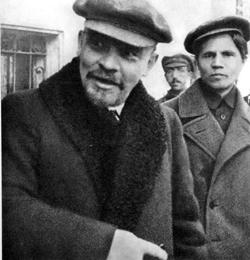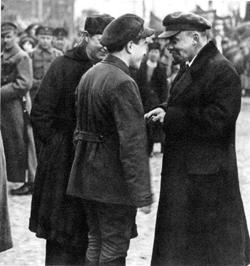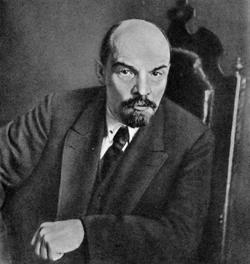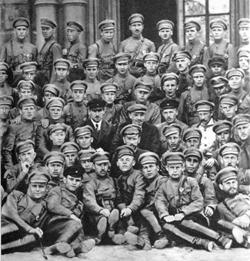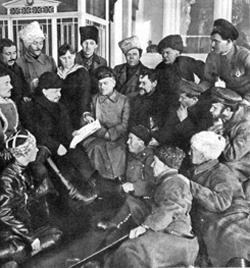Work of V.I. Lenin in the organisation of the country's defence (1918-1920)
Soviet poster.1920By the summer of 1918, the Soviet country was surrounded by the fire of front-lines. Three-fourths of the country's territory had been captured by the enemies. A map is exhibited in the hall that clearly demonstrates the critical position of the republic toward summer of that year, and the documents reveal the intense work of V.I. Lenin in the organisation of the country's defence.
Lenin presides at a meeting of the Council of People's Commissars in 1918 upon recovery from his woundsThe photographs and documents relate the execution of the "military communism" policy, under which the peasants were obliged to hand over to the State all surplus food-stuffs for a fixed price. A universal labour conscription and food-card system for the population were introduced, and private trade was forbidden. Food-cards were given only to those who worked. This was all a temporary, absolutely necessary measure called forth by the war, economic devastation and the extremely meagre reserve of food-stuffs in the country. The materials on exposition show how the revolutionary movement in capitalist countries was increasing under the influence of the victory of the Great October Socialist Revolution. The Communist Party and the Soviet Government, true to the principles of proletarian internationalism, did everything possible to render brotherly aid to peoples in the struggle for social liberation. In this period Communist parties were being formed in various countries. V. I. Lenin gave great consideration to the world-wide revolutionary movement. The Third Communist International was founded as a result of his initiative at the International Conference of Communists held in Moscow, in March 1919. The emblem of the Comintern (Communist International), done in bas-relief, and a photograph of the Presidium of the Congress of the Comintern, of which Lenin was a member, is displayed in the hall.
Lenin speaks from a balcony of the Moscow Soviet building, addressing the communist soldiers leaving for the front. 1919The documents of the 8th Congress of the Russian Communist Party (Bolsheviks), which was held in March of 1919 are exhibited in the centre of this hall. At this Congress the new Party Programme was accepted. All the principal parts of its draft were written by Lenin. The Programme defined the Party's tasks in the entire period of transition from capitalism to socialism, the period of construction of socialist society. The programme emphasised that the development of the country's productive forces and the transformation of the means of production into national property were the most important and decisive points in Party policy. The programme set forth the tasks of the socialist reconstruction of agriculture by creating state-run and co-operative farms, named measures for the rendering of material and technical assistance to agriculture and the improvement of the welfare and cultural level of the working people. Among the documents from the Congress on display in the hall the proof-readings of the Programme with Lenin's corrections usually draw the attention of visitors.
Vladimir Lenin. 1920In spring 1919, the position of the young republic proved very grave. The internal counter-revolutionary armies and interventionists expanded their offensive on six fronts. In this complicated situation Lenin' turned to the people and to the Party. His articles, "Theses of the Central Committee of the Russian Communist Party (Bolsheviks) on the Situation on the Eastern Front", "All Out for the Fight Against Denikin!", "To Comrade Soldiers of the Red Army", and others are on exhibition. Thanks to the tremendous organisational work by the Central Committee of the Party and Lenin personally, and thanks to the heroic efforts of the working class and the boundless courage of the Red Army, the young Soviet Republic held out and shifted from the defensive to the offensive.
Lenin addressing Red Army units leaving for the front. 1920.In this hall the documentary film, "Lenin at the Head of the Defence of the Soviet Republic", is demonstrated. The banners awarded the front-line troops of the Red Army by the All-Russia Central Executive Committee, and models of military technology from the times of the Civil War are displayed here. The many photographs hanging on the wall to the right of the entrance portray the renowned generals and heroes of the Civil War, the first Soviet military figures and Party leaders. Thousands of internationalists took their stand under the banner of the October Revolution. Several of them are shown here in the photographs: Mihai Bujor (Romania), Jaroslav Hasek (Czechoslovakia), Oleco Dundic (Yugoslavia), Bela Kun (Hungary), Jeanne Labourbe (France), Paou Ti-san (China), John Reed (America), and Karol Swier-czewski (Poland). See also: World communist leaders speak on Lenin and other historical documents and photos at the Defend Lenin mausoleum! site. The Communist Party did not stop work in the formation of the new socialist society under the conditions of intervention and Civil War. The exposition materials show how "Communist Subbotniks" (Saturdays) were born in this country upon the initiative of the Communists. This was a new form of social labour, without pay during free time. Lenin valued these subbotniks highly, calling them the "great beginning", the sprouts of a new, communist attitude to work. Since that time the All-Russia Communist Subbotniks have become a tradition with the Soviet people.
Lenin speaks at the unveiling of the monument to Stepan Razin. 1919.Gifts to V. I. Lenin from the Red Army and working people are displayed in the hall. There are a Red Army green overcoat with red fastenings, a belt with a holster, two budenovkos (a special hat similar to the ancient Russian helmet) and boots in the display case. The exposition in this hall concludes with V. I. Lenin's theoretical works On the Dictatorship of the Proletariat and The Economics and Politics in the Era of the Dictatorship of the Proletariat. In these works he developed the Marxist teaching on the transition period from capitalism to socialism, and set forth the most important problems in the construction of a new society. In spite of the difficult times in Russia, in 1919 Lenin gave constant consideration to questions of theory. N. K. Krupskaya wrote later: "llyich's ability to study theory at the most critical point of struggle always amazed me; he searched for the solution of practical questions in theory."
RSDLP Programm.
Lenin at the Vsevobuch parade. 1919.
Lenin sitting in the lorry which made an improvised speaker's platform for him at the Vsevobuch parade. 1919.
Lenin is shown leaving the House of Unions after a session of the First All-Russia Congress on education. 1919
Lenin in Red Square speaking with V. M. Zagorsky, Secretary of the Moscow Party Committee. 1919.
V. I. Lenin, chairman of the Council of Workers' and Peasants' Defence. 1919.
Lenin among the graduates of the Kremlin machine-gunners training courses. 1920.
Lenin in Red Square, speaking with Comrade Szamuely, Commissar for Military Affairs of the Hungarian Soviet Republic. 1919.
V. I. Lenin and M. I. Kalinin among the delegates to the First All-Russia Congress of Toiling Cossacks. 1920Defeat of Interventionists and Internal Counter-revolution |
